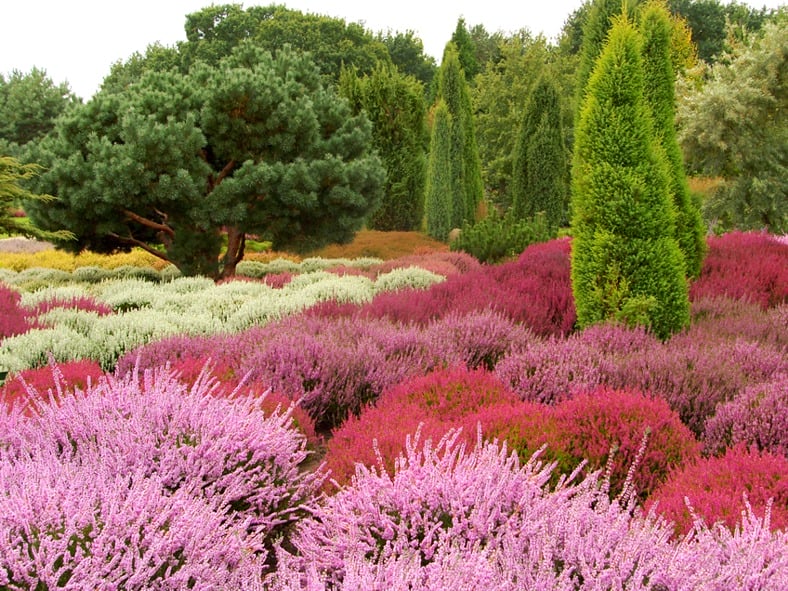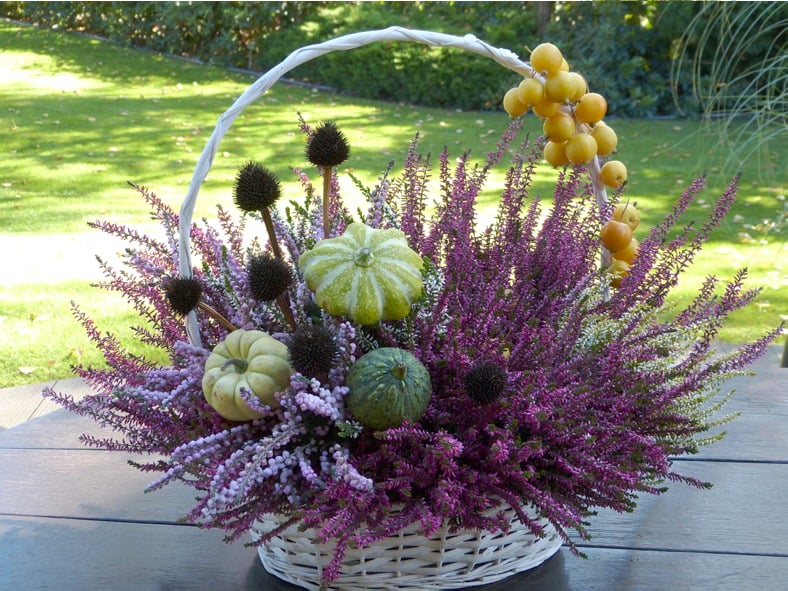

Heather and heath usually takes the form of a small bush or dwarf shrub with evergreen scaly (heather) or needle-shaped (heath) leaves. The spectacular blossoming, colour of leaves and variety of forms make them perfect for any garden design. They are highly decorative plants but on one condition – they must be planted in well prepared ground. Similarly to perennials, they are often the "make-up" of the garden, giving it finishing touches. The most magnificent effects are obtained if they grow in abundance, as well as in combination with other ornamental plants, such as dwarf conifers, brooms and birches.
Heaths and heathers can embellish your garden not only when they blossom but all your long. Once they grow together into one cluster, they form exquisite carpeting in various shades of green and yellow.
Buddy heathers are a highly interesting group as their buds do not open. As a result, they keep their colour for a long time, thus remaining attractive at all times, even in winter. Due to the wide range of their colours, long blossoming period and good frost resistance, they offer a spectacular decoration, not only for gardens. You may also use buddy heathers to embellish windows, balconies and terraces. They go well with conifers in the same containers, and they may grow in pots previously used for annual summer plants Buddy heathers are increasingly often used at graves. More modest than chrysanthemum but much cheaper and not afraid of frost, they are perfect for All Saints Day. Planted in a decorative pot and dried, they may adorn your home throughout the whole winter.
Plant heather in groups of 10-15 plants per variety, about 20-30 cm from one another. This usually gives 10-15 plants per square metre. Heathers and heaths should be planted deep enough for their bottom branches to be able to touch the ground. Afterwards, water the plants thoroughly, and spread a several-centimetre thick layer of pulped pine bark on the ground around them. Bark prevents excessive water evaporation, limits the growth of weed and protects the root system against frost.
Heathers and heaths are not very demanding. They should be fertilised once a year, in early spring. You may use multi-nutrient fertilisers such as Azofoska, Hydrocomplex, slow-release fertilisers such as Osmocote, or fertilisers for acidophilic plants.


The majority of heather and heath varieties must be covered for the winter. Twigs of coniferous plants are a good cover. Instead of them, you may use jute mesh, non-woven crop cover or plastic shading net (it will suffice for a few seasons). Never cover the plants with leaves, straw or plastic film.
Pruning is a very important activity, crucial for proper growth of plants. It helps keep them dense and maximise the quantity of flowers. Use secateurs to prune small plants, and shears for smaller specimens growing in clusters. Always prune below overblown flowers. Prune heathers and some heath species such as Erica tetralix, Erica vagans, Erica watsonii in early spring, while pruning of Erica carnea, Erica darleyensis leave for May, the beginning of June, immediately after they shed blossom.
Heathers and heaths are practically immune to pests and diseases if they grow in a suitable place and are properly tended. At times, they may be attacked by Botrytis (grey mould), Rhizoctonia, Pythium, Glomorella fungi. The most disease incidents are noted in July. This is due to high air humidity and temperature. We recommend preventive spraying in June, July, using generally available fungicides, such as Sarbravit, Rovral, Euparen.
Creating a heather garden, you can select heather and heath varieties in such a way as to ensure continuous blooming from February to November. The first half of February is when the first heaths start to blossom, e.g. winter heath (Erica carnea), the "Winter Beauty" variety. March, April and May is when the majority of heath varities are in bloom. The second half of June marks the blossoming of cross-leaved heath (Erica tetralix), Watson's heath (Erica watsonii), bell heather (Erica cinerea), and slightly later –Cornish heath (Erica vagans). The earliest verities blossom in July, and the latest ones – until the end of November.